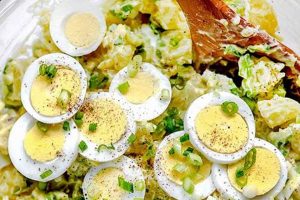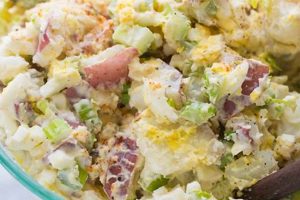This dish combines the heartiness of baked potatoes with the creamy, tangy flavors of traditional potato salad. Imagine fluffy baked potatoes, cooled and cubed, then tossed with a flavorful dressing and other classic potato salad ingredients like celery, onion, and hard-boiled eggs. Variations can include additions such as bacon, cheese, or different herbs and spices, creating a versatile and customizable side dish.
The appeal lies in the textural contrast between the creamy dressing and the soft, yet substantial, baked potato pieces. This offers a heartier, more satisfying alternative to standard potato salad made with boiled potatoes. Using baked potatoes also imparts a subtle roasted flavor that enhances the overall dish. This approach can be a creative way to utilize leftover baked potatoes, minimizing food waste while offering a unique culinary experience. Historically, potato salad emerged as a popular dish in Europe, eventually making its way to the Americas. Adapting it to feature baked potatoes adds a modern twist to this classic comfort food.
This exploration will delve into variations on the recipe, provide tips for achieving optimal results, and discuss suitable pairings for different occasions.
Tips for Creating Exceptional Baked Potato Potato Salad
Achieving a perfect balance of flavor and texture requires attention to detail throughout the preparation process. These tips offer guidance for creating a truly memorable dish.
Tip 1: Potato Selection: Opt for russet or Yukon Gold potatoes. These varieties offer the ideal balance of fluffiness and structure, holding their shape well after baking and mixing.
Tip 2: Baking Technique: Bake potatoes until tender but not mushy. Piercing the skins before baking allows steam to escape, promoting even cooking. Avoid overbaking, which can result in a dry, crumbly texture.
Tip 3: Cooling and Handling: Allow the baked potatoes to cool completely before handling and cubing. This prevents the potatoes from becoming gummy and ensures cleaner cuts.
Tip 4: Dressing Consistency: The dressing should be creamy and flavorful but not overly thick. Adjust the amount of mayonnaise or other creamy ingredients to achieve the desired consistency.
Tip 5: Ingredient Incorporation: Gently fold the dressing and other ingredients into the cubed potatoes to avoid breaking them down. This maintains the desired texture and visual appeal.
Tip 6: Chilling Time: Allow the salad to chill for at least an hour before serving. This allows the flavors to meld and the salad to reach the ideal serving temperature.
Tip 7: Garnishing and Presentation: A sprinkle of fresh herbs, such as chives or parsley, adds a touch of freshness and visual appeal. Consider serving the salad in a rustic bowl or on a platter garnished with lettuce leaves.
By following these tips, one can elevate this dish from a simple side to a culinary centerpiece. Attention to these details ensures a flavorful, visually appealing, and texturally satisfying experience.
These techniques contribute to a final product that is both delicious and visually appealing, a satisfying complement to any meal.
1. Baked, not boiled potatoes
The distinction between baked and boiled potatoes is paramount in a baked potato potato salad recipe. This choice significantly influences the final dish’s texture, flavor, and overall appeal. Boiling potatoes results in a softer, water-logged consistency, whereas baking yields a firmer, drier potato with a distinctive roasted flavor. This foundational difference sets the stage for a unique culinary experience.
- Texture and Structure
Baking creates a fluffy interior and a slightly crisp skin, providing textural complexity within the salad. This contrasts with the uniform softness of boiled potatoes. The firmer texture of baked potatoes holds up better in the salad, preventing them from becoming mushy when mixed with the dressing and other ingredients. This structural integrity is crucial for a visually appealing and satisfying potato salad.
- Flavor Profile
The dry heat of the oven caramelizes the natural sugars in the potatoes, imparting a subtly sweet and nutty flavor that complements the other ingredients. Boiling, on the other hand, leaches out some of these sugars and dilutes the potato flavor. This concentrated flavor profile enhances the overall complexity of the salad.
- Moisture Content
Baked potatoes retain less moisture than boiled potatoes. This drier consistency prevents the salad from becoming watery and allows the dressing to coat the potatoes more effectively, enhancing flavor adhesion and preventing dilution. This is essential for achieving a balanced and flavorful salad.
- Visual Appeal
The slightly browned exterior of baked potatoes adds visual interest to the salad, contrasting with the pale color of boiled potatoes. This visual appeal enhances the overall presentation and makes the salad more enticing.
The choice of baked potatoes contributes significantly to the distinctive character of this potato salad. The resulting textural complexity, enhanced flavor profile, controlled moisture content, and visual appeal distinguish this dish from traditional potato salads made with boiled potatoes. The baking process creates a robust foundation that complements the other ingredients and elevates the overall culinary experience.
2. Textural Contrast
Textural contrast forms a defining characteristic of baked potato potato salad. Unlike versions using boiled potatoes, which offer a uniform softness, this variation introduces a dynamic interplay of textures that elevates the sensory experience. The fluffy interior of the baked potato yields easily to the bite, while the skin provides a subtle chewiness. This inherent textural variation within the potato itself lays the groundwork for further complexity.
The creamy dressing, a standard component of potato salad, provides a smooth counterpoint to the potato’s textural duality. This juxtaposition of creamy and yielding against fluffy and slightly firm creates a pleasing mouthfeel. The addition of crisp ingredients, such as celery and onion, further amplifies the textural contrast. These elements introduce a refreshing crunch, enhancing the overall sensory experience. Consider the interplay: a forkful might include the soft interior of a potato piece coated in creamy dressing, alongside a bit of crunchy celery and a hint of chewy skin. This layered textural experience distinguishes the dish.
Understanding the importance of textural contrast enables informed choices regarding ingredient selection and preparation methods. For instance, slightly underbaking the potatoes can enhance their firmness, contributing to a more pronounced contrast. Similarly, choosing crisp vegetables like bell peppers or radishes can add another layer of textural complexity. Achieving a desirable balance requires careful consideration of the interplay between soft, creamy, and crisp elements. This deliberate construction of textural contrast elevates the baked potato potato salad beyond a simple side dish to a more engaging culinary experience.
3. Flavorful Dressing
Flavorful dressing constitutes a crucial element in baked potato potato salad, significantly impacting the overall taste experience. The inherent subtlety of baked potatoes, while offering a pleasant roasted note, necessitates a dressing that provides depth and complexity. The dressing acts as a unifying agent, binding the various components while contributing its own distinctive character. A bland or poorly conceived dressing can undermine the dish, rendering it underwhelming despite the quality of other ingredients.
Several factors contribute to a successful dressing. Acidity, typically derived from vinegar or lemon juice, provides brightness and balances the richness of the mayonnaise or other creamy base. Mustard adds sharpness and depth, while herbs and spices offer aromatic complexity. Sweetness, often from a touch of sugar or relish, rounds out the flavor profile. Consider a classic Dijon vinaigrette, where the tangy mustard complements the subtle sweetness of the potatoes. Alternatively, a creamy dressing infused with fresh dill and chives provides a vibrant herbal counterpoint. The interplay of these elements creates a dynamic flavor profile that complements the hearty baked potatoes and other ingredients.
The practical significance of a flavorful dressing lies in its ability to elevate the entire dish. It transforms a simple collection of ingredients into a cohesive and satisfying culinary experience. Challenges arise when the dressing overwhelms the other flavors or lacks balance. A dressing overly reliant on mayonnaise can become cloying, while insufficient acidity can result in a flat, uninteresting taste. Careful consideration of flavor profiles and ingredient proportions ensures a harmonious balance that enhances, rather than masks, the inherent qualities of the baked potato potato salad. The right dressing transforms the individual components into a unified and delicious whole, demonstrating the critical role of flavor balance in achieving culinary success.
4. Complementary Ingredients
Complementary ingredients play a vital role in baked potato potato salad, enhancing both its flavor profile and textural complexity. While the baked potatoes provide a substantial base, these additions contribute crucial dimensions that elevate the dish beyond simple roasted potatoes mixed with dressing. The selection and balance of these ingredients directly impact the overall culinary experience, transforming a basic concept into a multifaceted and satisfying dish.
Classic potato salad ingredients like celery and red onion offer a crisp, refreshing counterpoint to the soft potatoes and creamy dressing. Their sharp flavors cut through the richness, preventing the salad from becoming overly heavy. Hard-boiled eggs contribute a creamy texture and subtle savory note, while pickles introduce a tangy complexity. These additions create a balanced flavor profile, where each element complements the others without overwhelming the palate. Consider the interplay of crunchy celery, pungent red onion, and creamy egg against the backdrop of fluffy potatoes and tangy dressing. This dynamic interplay of flavors and textures distinguishes the dish from a simple potato salad. Expanding beyond traditional ingredients, additions like bacon or crumbled blue cheese introduce smoky or sharp notes, further enriching the flavor profile. Fresh herbs, such as dill, chives, or parsley, contribute brightness and aromatic complexity. These carefully chosen ingredients transform the salad into a more sophisticated and nuanced culinary creation.
Understanding the role of complementary ingredients allows for informed customization and adaptation. Dietary restrictions can be accommodated by substituting ingredients; for example, vegan mayonnaise can replace traditional mayonnaise, and avocado can provide creaminess in place of eggs. Flavor preferences can be addressed by adjusting the proportions of ingredients or introducing new elements. A preference for spicier flavors might lead to the inclusion of chopped jalapeos or a dash of hot sauce. The versatility of this dish lies in its adaptability. However, challenges can arise from an imbalance of flavors or textures. Too much of a single ingredient, like an overwhelming amount of raw onion, can disrupt the harmony. Careful consideration of flavor profiles and ingredient proportions is essential for achieving a balanced and satisfying result. The strategic selection and balanced incorporation of complementary ingredients elevates the baked potato potato salad, transforming it from a simple side dish into a more complex and enjoyable culinary experience.
5. Proper Cooling Technique
Proper cooling technique is essential for a successful baked potato potato salad recipe. Cooling the baked potatoes thoroughly before handling and incorporating them into the salad directly impacts the final dish’s texture, flavor, and food safety. Neglecting this step can lead to a suboptimal result, impacting both the culinary experience and the potential for bacterial growth.
Warm potatoes, when combined with the dressing and other ingredients, create a gummy, unappetizing texture. The heat causes the starches in the potatoes to break down, resulting in a sticky consistency rather than the desired fluffy texture. Furthermore, residual heat can accelerate the breakdown of the dressing itself, particularly mayonnaise-based dressings, leading to a separated and less visually appealing salad. From a food safety perspective, warm potatoes create an ideal environment for bacterial growth, potentially leading to spoilage or foodborne illness if not properly cooled and refrigerated.
Effective cooling methods involve spreading the baked potatoes on a wire rack or baking sheet after removing them from the oven. This allows air to circulate around the potatoes, promoting even cooling. Avoid stacking warm potatoes, as this traps heat and slows down the cooling process. Ideally, potatoes should reach room temperature before being handled and cubed for the salad. Refrigerating the cooled potatoes for a short period before combining them with the other ingredients can further enhance the desired texture and improve food safety. Understanding the impact of temperature on the potatoes and the other ingredients underscores the importance of proper cooling technique in achieving a successful baked potato potato salad. This seemingly minor step plays a significant role in preserving the desired texture, preventing the breakdown of the dressing, and minimizing food safety risks, ultimately contributing to a more enjoyable and safer culinary experience.
6. Chilling Time
Chilling time represents a crucial step in preparing baked potato potato salad, significantly influencing the final dish’s flavor development and overall quality. This period of refrigeration, typically at least one hour, allows the complex flavors of the various ingredients to meld and harmonize, creating a more cohesive and nuanced taste experience. The chilling process also firms the potatoes, enhancing their textural integrity within the salad and preventing them from becoming mushy. Furthermore, chilling allows the dressing to fully emulsify and coat the potatoes, ensuring even distribution of flavor and preventing dilution.
Consider the impact on flavor: the subtle roasted notes of the baked potatoes intertwine with the tanginess of the dressing, the sharpness of the onions and celery, and the creaminess of the eggs. Chilling allows these individual flavors to marry, creating a more complex and balanced profile than immediately after mixing. The textural impact is equally significant. Chilled potatoes hold their shape better, providing a pleasant contrast to the creamy dressing and other ingredients. Without sufficient chilling time, the potatoes may absorb too much dressing, resulting in a softer, less appealing texture. A practical example illustrates this: imagine serving the salad immediately after mixing versus after a two-hour chill. The former presents a less cohesive dish, with distinct flavors vying for attention and a potentially less appealing texture. The latter offers a harmonious blend of flavors and a more refined textural experience.
The practical significance of understanding chilling time lies in its impact on the overall culinary experience. Proper chilling elevates the dish, maximizing flavor development and ensuring a desirable texture. Challenges arise when time constraints limit chilling time. While some flavor melding occurs even with minimal chilling, the full potential of the dish is realized with adequate refrigeration. Balancing time constraints with the desire for optimal flavor and texture represents a common culinary challenge. Recognizing the importance of chilling time allows for informed decisions and prioritization, contributing to a more satisfying culinary outcome. This seemingly simple step plays a crucial role in the final product, demonstrating the significant impact of time and temperature on flavor development and textural integrity in culinary preparations.
7. Presentation
Presentation plays a significant role in the overall enjoyment of baked potato potato salad. While flavor and texture are paramount, visual appeal enhances the dining experience, stimulating appetite and creating a sense of anticipation. Thoughtful presentation elevates this dish from a simple side to a more engaging culinary offering. Consideration of color, texture, and serving style contributes to a more appealing and satisfying experience.
- Color Palette
The natural color palette of baked potato potato salad tends towards muted tones. The creamy dressing, off-white potatoes, and pale yellow yolks of hard-boiled eggs create a relatively neutral backdrop. Strategic use of colorful ingredients enhances visual appeal. Incorporating vibrant elements like chopped red onion, green bell peppers, or brightly colored herbs such as parsley or chives introduces visual interest and contrasts with the more subdued tones of the base ingredients. A sprinkle of paprika adds a warm, reddish hue. These additions create visual focal points, enhancing the overall presentation.
- Textural Variation
Visual texture plays a crucial role alongside the physical textures experienced when eating. The contrast between the smooth, creamy dressing and the rougher surfaces of the cubed potatoes creates visual interest. Incorporating ingredients with different textures, such as crunchy celery or crumbled bacon, further enhances this visual dimension. These variations capture the eye and create a more dynamic presentation, contributing to a sense of anticipation and enjoyment.
- Serving Vessels and Garnishes
The choice of serving vessel contributes significantly to the overall presentation. A rustic wooden bowl conveys a sense of homestyle comfort, while a sleek glass bowl presents a more modern aesthetic. Garnishes provide finishing touches that enhance visual appeal. A simple sprig of fresh herbs, a sprinkle of paprika, or a scattering of chopped chives elevates the presentation, adding a touch of elegance and signaling attention to detail. These seemingly minor additions significantly impact the perceived value and enjoyment of the dish.
- Context and Occasion
Presentation considerations should also reflect the context and occasion. A casual backyard barbecue might call for a simple, unfussy presentation in a large bowl, while a more formal dinner party might warrant individual portions plated with artistic flair. Adapting the presentation to the specific setting demonstrates consideration for the dining experience and enhances the overall enjoyment of the baked potato potato salad.
The presentation of baked potato potato salad, while often overlooked, significantly contributes to its overall appeal. Careful consideration of color, texture, serving style, and context elevates this dish from a simple side to a more engaging culinary experience. By attending to these visual elements, one can enhance the enjoyment of this classic comfort food, transforming it into a more visually appealing and satisfying dish. The interplay of these visual elements demonstrates how presentation enhances the dining experience, creating a sense of anticipation and pleasure that complements the flavors and textures of the dish itself.
Frequently Asked Questions
This section addresses common inquiries regarding the preparation and enjoyment of baked potato potato salad.
Question 1: Can other potato varieties be used besides russet or Yukon Gold?
While russet and Yukon Gold potatoes are recommended for their texture and flavor, other varieties like red potatoes or fingerling potatoes can be used. However, these may result in a slightly different texture and may not hold their shape as well.
Question 2: How can one prevent the potatoes from becoming overly dry when baking?
Rubbing the potato skins with olive oil before baking helps retain moisture and promotes even browning. Baking in foil can also help prevent dryness, but it may result in a softer skin.
Question 3: What are suitable alternatives to mayonnaise in the dressing?
Plain Greek yogurt, sour cream, or a combination of the two can be used as alternatives to mayonnaise, offering a lighter and tangier flavor profile. Avocado can also be used for a vegan and creamy option.
Question 4: How long can baked potato potato salad be stored in the refrigerator?
Properly stored in an airtight container, it can be refrigerated for up to three to five days. However, the quality and texture may begin to deteriorate after the first two days.
Question 5: Can this salad be served warm?
While traditionally served cold, it can be served warm for a different flavor experience. However, the texture will be softer, and the dressing may not adhere as well. Ensure the potatoes are not overly hot when mixing to prevent the dressing from breaking down.
Question 6: How can the nutritional value of the salad be increased?
Incorporating additional vegetables, such as chopped bell peppers, carrots, or green beans, increases the nutritional content. Using a lighter dressing and reducing the amount of added salt and sugar can also contribute to a healthier version.
Addressing these common questions provides clarity and guidance for those seeking to prepare and enjoy this dish. Understanding the nuances of preparation and storage ensures a successful culinary experience.
This concludes the frequently asked questions section. The following section will offer concluding thoughts and recipe variations.
Culinary Exploration of Baked Potato Potato Salad Concludes
This exploration has provided a comprehensive overview of the baked potato potato salad recipe, highlighting its key distinctions from traditional potato salad. The emphasis on using baked, rather than boiled, potatoes establishes a foundation of textural complexity and enhanced flavor derived from the roasting process. The importance of a well-balanced, flavorful dressing, the strategic incorporation of complementary ingredients, and the critical role of proper cooling and chilling techniques were examined. Presentation, often overlooked, was also addressed as a vital component contributing to the overall dining experience. These combined elements contribute to a dish that offers both satisfying flavors and a visually appealing presentation.
This dish represents a versatile culinary canvas, adaptable to individual preferences and dietary needs. Further exploration of flavor profiles and ingredient combinations offers a pathway to continuous culinary discovery. The potential for creative variations, coupled with an understanding of core principles, empowers culinary enthusiasts to elevate this classic comfort food to new heights. One might consider the incorporation of regional spices, the exploration of alternative dressing bases, or the addition of seasonal vegetables to further personalize this versatile dish. The possibilities for customization are vast, offering a continuous journey of culinary exploration and enjoyment.






